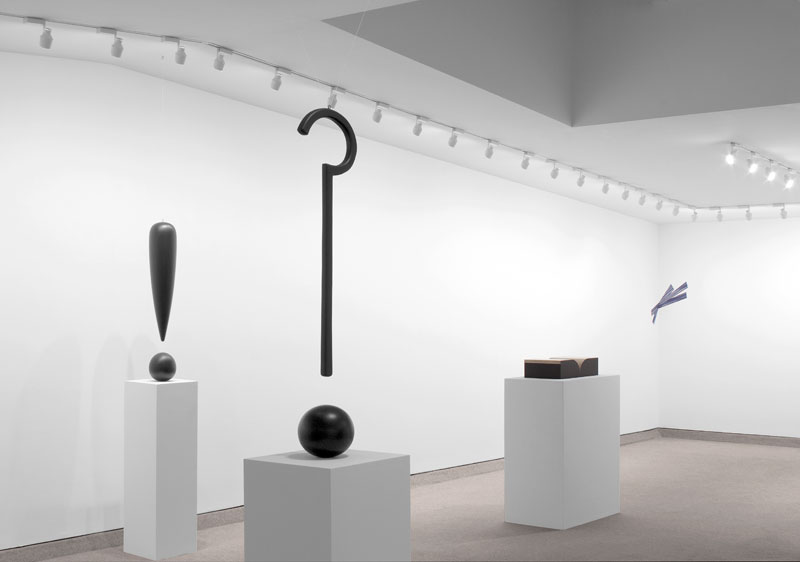
Exhibition View
The work of Richard Artschwager does not take to labels easily, as it incorporates and/or quotes elements of Conceptualism, Minimalism, Pop, Photorealism and Surrealism, among others. In a partial homage to Artschwager’s singular, yet quotation-filled approach, we have compiled a series of statements by the artist and by others that relate both to the specific works on display in this exhibition as well as to his general approach.
PUNCTUATION MARKS
Adam Weinberg, director of the Whitney Museum of American art, in describing Richard Artschwager’s punctuation marks, wrote that, “they appear as humorous, sensuous forms – yet mute ones, detached from the dramatic feeling or sound that they would imply in a text. Decontextualizing the emotion associated with the mark contradictorily summons an existential loneliness.”
TIME PIECE AND BOOK
Artschwager’s “Time Piece” and “Book” both look like the objects described in their titles. Both have veneered surfaces. The “book” has no words and no pages, yet the clock is fully functional. They are the same yet opposites. Speaking about works using the veneer and veneer being a photographic image of a material, Artschwager stated, “it was a picture of a piece of wood. If you take that and make something out of it, then you have an object. But it’s a picture of something at the same time, it’s an object.”
ARTSCHWAGER’s COMFORT WITH SIMULTANEOUS COMPREHENSION AND OPAQUENESS
“Ever since our mind learned to fly out of our bodies, we have been moving rapidly from the accessible to the inaccessible, and back, rapidly, most likely because the accessible and the inaccessible have been trading places very fast. Maybe the mind is actually staying right where it is.”
MULTIPLICITY IN MEANING AND EXPERIENCE
In Artschwager’s 1967 essay, “The Hydraulic Door Check”, he states, “The most striking property of doors (although not unique to doors) is RESONANCE between two states, which can be conveniently labels as “open” and “closed”. Resonance is never a simple, unqualified fluctuation between two states; even so in this case. A door – at any given moment – is in a state of being closed with the possibility of its being opened, or in a state of being open with the possibility of its being closed. This is not a speculative model for a door but a description of the state of affairs which immediately existed when the first door was brought into being.” One can expand this notion to an understanding of several of Artschwager’s motifs – 1) veneer as an image of material turned back into a physical object and 2) punctuation marks as physical silent objects completely out of written context yet have the opportunity to comment on all that is around.
ART AS AN OPPORTUNITY TO FULLY EXPERIENCE ALL THAT WHICH IS AROUND
Artschwager stated, “I’m not talking about the apparatus, I’m talking about our being in a primarily social, as opposed to primarily physical, space. Our physical space has been eroded to the point of being endangered, it survives where there are few people and lots of space and where a person or persons can reside in pleasurable solipsism – watching, listening, not editing or throwing anything away – Social space is language-bound and language is always subject-predicate, a Procrustean abridgment of the event which, for instance, allows no excluded middle – Just think back to that time when people lived in the country. One didn’t look at red and green lights – in other words, particles – in order to cross the street, but rather at the full field of vision. And so it is with Matisse. When you sweep your eyes over it, you’re seeing it as it was intended to be seen. It’s so simple.”
OPPOSITES
Richard Armstrong states “Richard Artschwager has sought to alter the context of viewing by making pictorial sculpture and dimensional, space-occupying paintings. Equally conceptual and physical, his work is not intended as a simple demonstration of thought or as a purely aesthetic experience. He engages mind and body by situating us in front of a thing, often familiar-looking and always convincingly well made.”
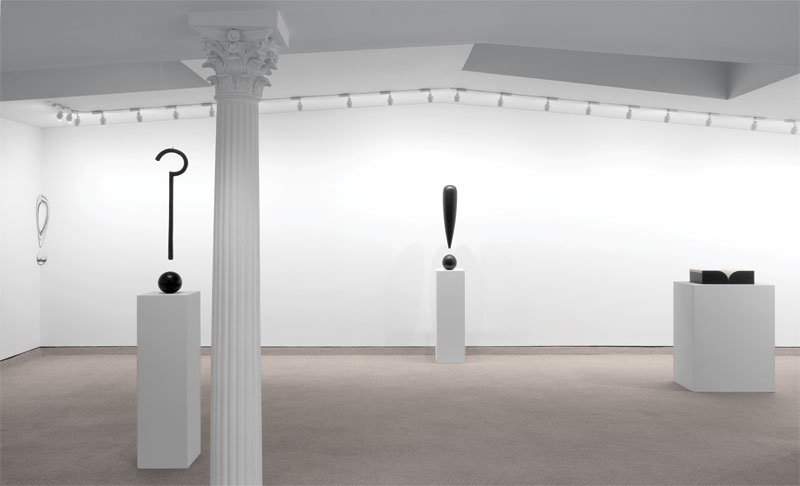
29 1/4 x 8 7/8 x 6 inches (74.3 x 22.5 x 15.2 cm)
Edition of 6
(Inventory #28281)
29 1/4 x 8 7/8 x 6 inches (74.3 x 22.5 x 15.2 cm)
Edition of 6
(Inventory #28281)
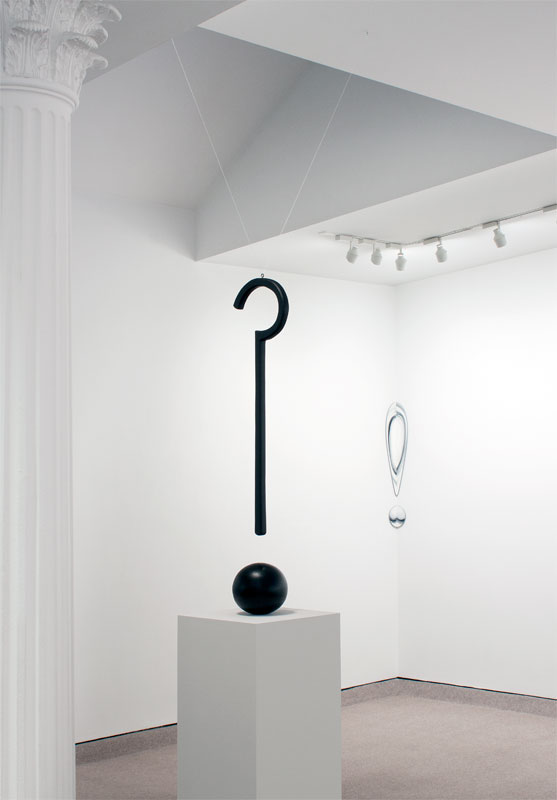
Overall dimensions, Part A: 25 x 6 x 4 inches (63.5 x 15.25 x 10 cm)
Overall dimensions, Part B: 6 x 5 x 3 inches (15.25 x 12.75 x 7.75 cm)
Edition of 30, and VI
Signed, dated and inscribed in ink verso of each
(Inventory #27009)
Overall dimensions, Part A: 25 x 6 x 4 inches (63.5 x 15.25 x 10 cm)
Overall dimensions, Part B: 6 x 5 x 3 inches (15.25 x 12.75 x 7.75 cm)
Edition of 30, and VI
Signed, dated and inscribed in ink verso of each
(Inventory #27009)
37 x 6 1/2 x 6 1/2 inches (94 x 16.5 x 16.5 cm)
Edition of 12
(Inventory #27902)
37 x 6 1/2 x 6 1/2 inches (94 x 16.5 x 16.5 cm)
Edition of 12
(Inventory #27902)
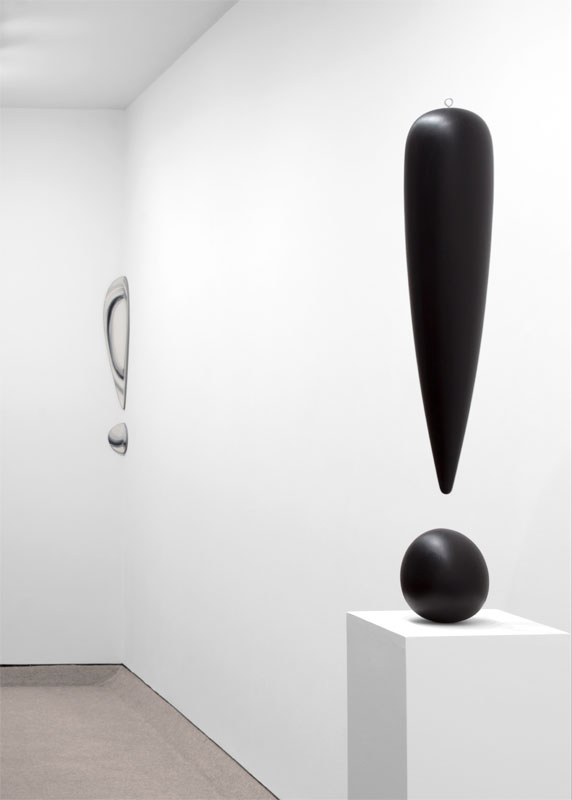
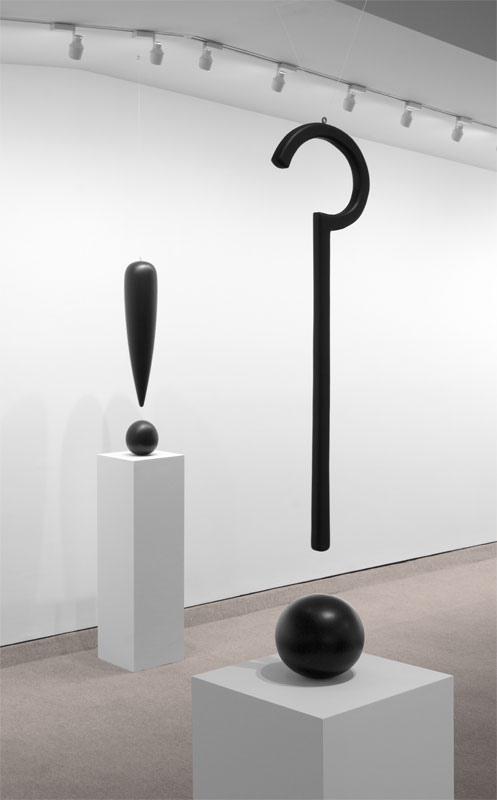
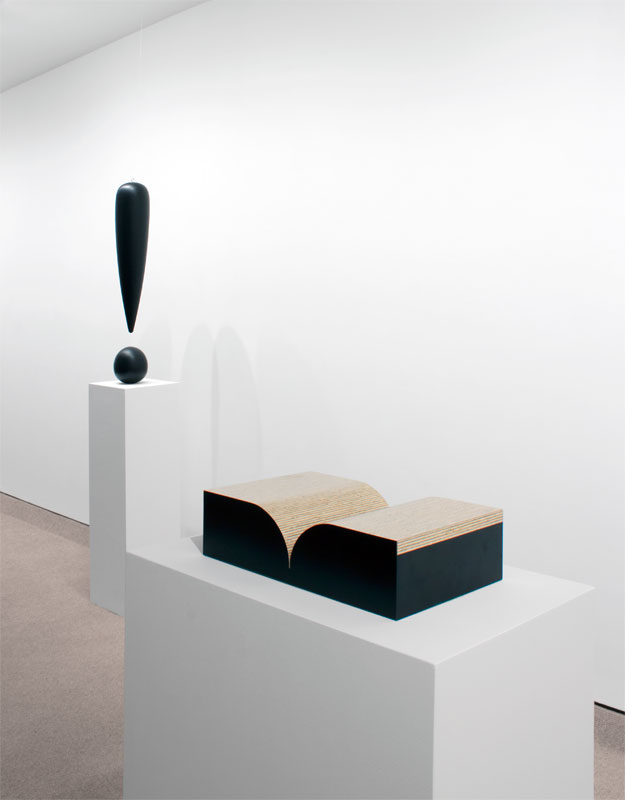
5 x 20 x 12 inches (12.7 x 50.8 x 30.5 cm)
Edition of 40
Signed and numbered on the underside
(Inventory #27855)
5 x 20 x 12 inches (12.7 x 50.8 x 30.5 cm)
Edition of 40
Signed and numbered on the underside
(Inventory #27855)
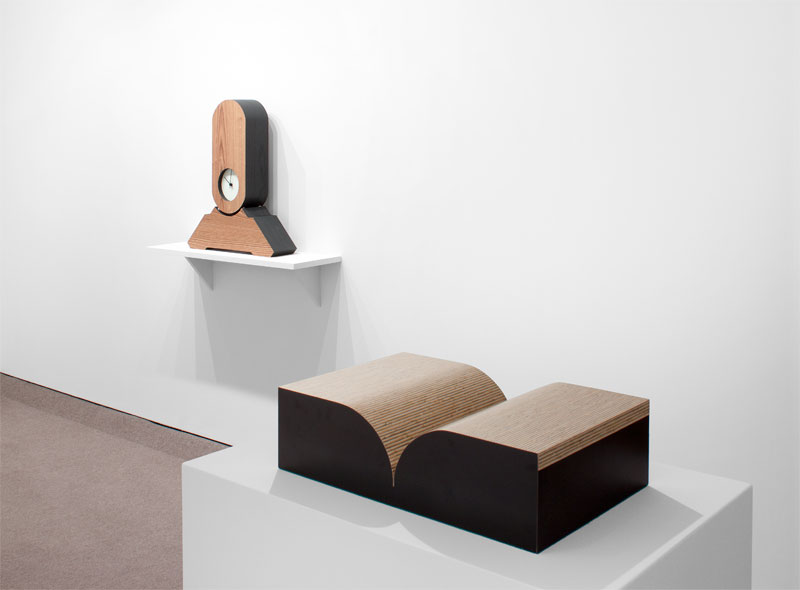
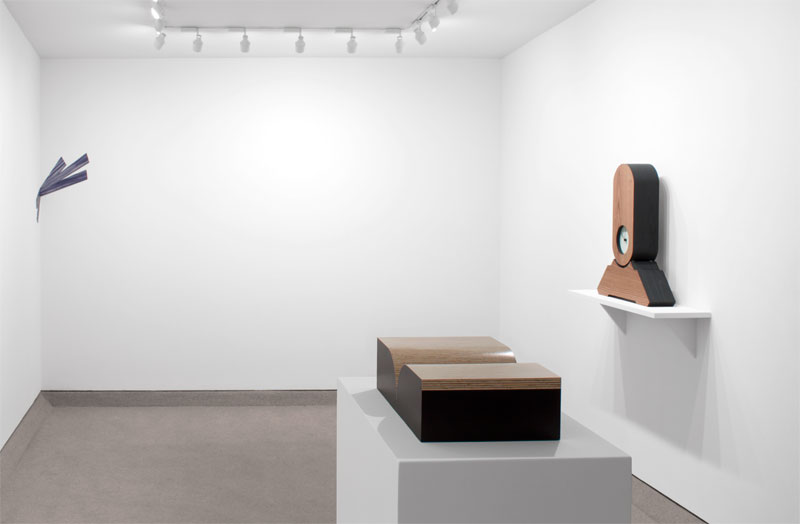
Signed and numbered on reverse of larger element
Different configurations and sizes, each unique in a series of twenty
This one: 17 1/8 x 22 1/4 inches
(Inventory #25363)
Signed and numbered on reverse of larger element
Different configurations and sizes, each unique in a series of twenty
This one: 17 1/8 x 22 1/4 inches
(Inventory #25363)
Clock element: 19 x 9 x 5 1/4 inches (48.3 x 22.9 x 13.3 cm)
Base element: 7 1/2 x 23 3/8 x 5 3/16 inches (19.1 x 59.4 x 13.2 cm)
Overall size: 25 1/2 x 23 3/8 x 5 3/16 inches (64.8 x 59.4 x 13.2 cm)
Edition of 30
Signed and numbered in ink on a label affixed to the base
(Inventory #27261)
Clock element: 19 x 9 x 5 1/4 inches (48.3 x 22.9 x 13.3 cm)
Base element: 7 1/2 x 23 3/8 x 5 3/16 inches (19.1 x 59.4 x 13.2 cm)
Overall size: 25 1/2 x 23 3/8 x 5 3/16 inches (64.8 x 59.4 x 13.2 cm)
Edition of 30
Signed and numbered in ink on a label affixed to the base
(Inventory #27261)
9 1/4 x 7 5/8 x 2 inches (23.5 x 19.4 x 5.1 cm)
Edition of 500
Signed and numbered
(Inventory #BK.26981)
9 1/4 x 7 5/8 x 2 inches (23.5 x 19.4 x 5.1 cm)
Edition of 500
Signed and numbered
(Inventory #BK.26981)
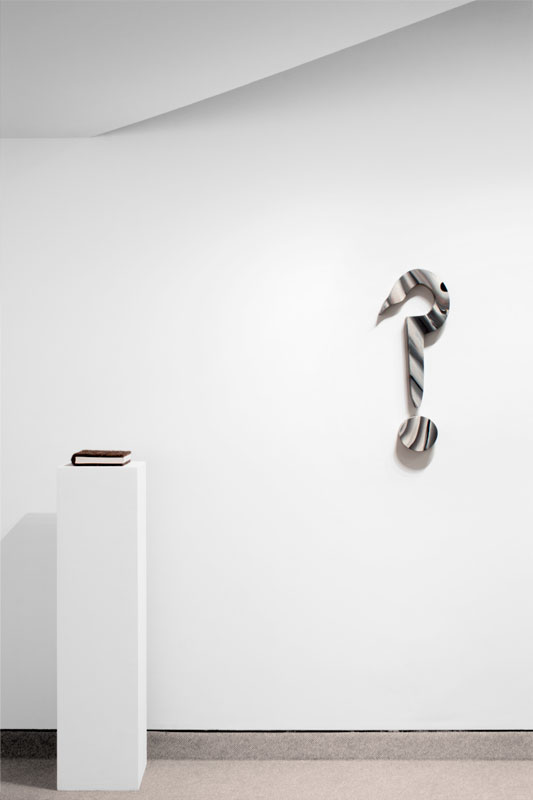
29 1/2 x 11 x 2 inches (74.9 x 27.9 x 5.1 cm)
Edition of 6
Signed, titled, numbered and dated on the reverse on each element
(Inventory #28280)
29 1/2 x 11 x 2 inches (74.9 x 27.9 x 5.1 cm)
Edition of 6
Signed, titled, numbered and dated on the reverse on each element
(Inventory #28280)
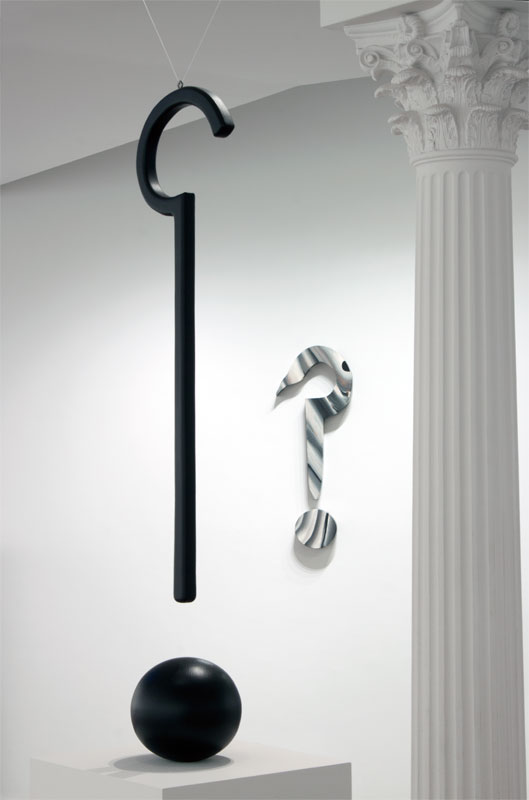
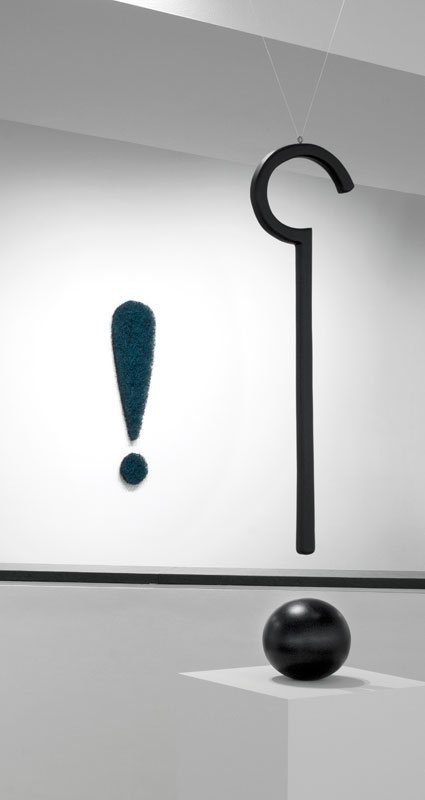
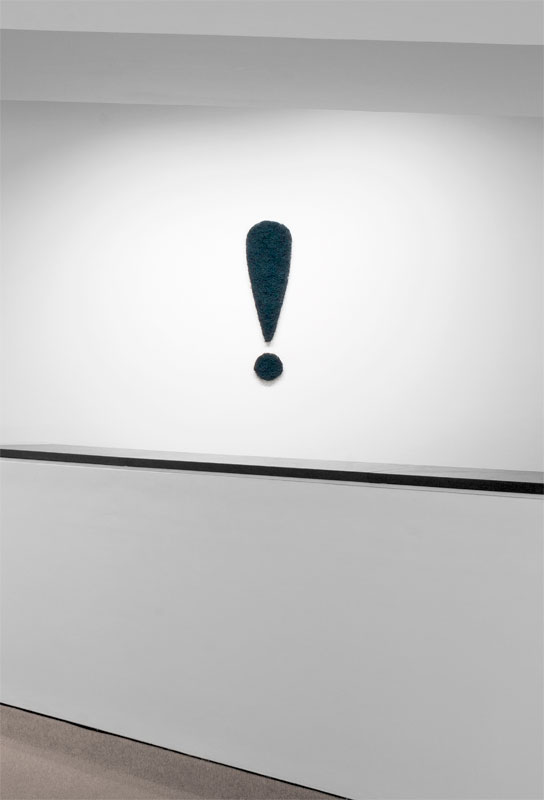
Overall size: 28 x 7 1/8 inches (71.1 x 18 cm)
Edition of 12
(Inventory #BK.21657)
Overall size: 28 x 7 1/8 inches (71.1 x 18 cm)
Edition of 12
(Inventory #BK.21657)
No results found.
10 Newbury Street, Boston, Massachusetts 02116
617-262-4490 | info@krakowwitkingallery.com
The gallery is free and open to the public. Please note our summer schedule:
July 1–25
Tuesday – Friday, 10–5:30
July 29 – September 1
Open by appointment
Beginning September 2
Tuesday – Saturday, 10–5:30